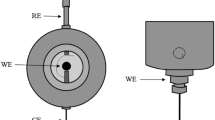Abstract
A new version of the chronoamperometric method, adapted to the determination of the oxidative (oxidant) activity of a medium on an example of chlorinated water, was proposed. The supporting solution contained K4Fe(CN)6. By its oxidation with oxidants present in the sample, K3Fe(CN)6 formed; its reduction current served as an analytical signal. The current of K3Fe(CN)6 reduction was recorded at a potential of 0 V, selected from the cyclic voltammogram of the K3Fe(CN)6/K4Fe(CN)6 system in the range where the oxidized form of the reagent was reduced and the reduced form was stable. A gold electrode was the measuring electrode. The possibility of using a stable solution of K3Fe(CN)6 as a component of a standard addition and as a solution for plotting a calibration curve was demonstrated. The limit of detection of the amount of dissolved chlorine and products of its interaction with water is 8 × 10–6 M. The data obtained by the proposed procedure and by the iodometric methods correlate well with each other (r = 0.93–0.95). The proposed version of the chronoamperometric method can be used to monitor the amount of dissolved chlorine and products of its interaction with water in water supply systems, pools, and disinfecting solutions and to determine other water-soluble oxidants.
Similar content being viewed by others
References
Zenkov, N.K., Lankin, V.Z., Men’shchikova, E.B., Okislitel’nyi stress. Biokhimicheskii i patofiziologicheskii aspekty (Oxidative Stress: Biochemical and Pathophysiological Aspects), Moscow: Nauka/Interperiodika, 2001.
SanPiN (Sanitary Rules and Norms) 2.1.4.1074-01: Drinking Water. Hygienic Requirements for Water Quality of Centralized Drinking Water Supply Systems. Quality Control, Moscow, 2001.
National Primary Drinking Water Regulations. https:// www.epa.gov/ground-water-and-drinking-water/tableregulated-drinking-water-contaminants. Cited August 26, 2016.
Free Radicals in Biology, Pryor, W.A., Ed., New York: Academic, 1976, vol.1.
Valgimigli, L., Pedulli, G.F., and Paolini, M., Free Radical Biol. Med., 2001, vol. 31, no. 6, p.708.
Vladimirov, Yu.A. and Proskurnina, E.V., Biochemistry (Moscow), 2009, vol. 74, no. 13, p. 1545.
Khasanov, V.V., Ryzhova, G.L., and Mal’tseva, E.V., Khim. Rastit. Syr’ya, 2004, no. 3, p.63.
Zhuravlev, A.I. and Pantyushenko, V.T., Svobodnoradikal’naya biologiya (Free Radical Biology) Moscow: Mosk. Vet. Akad., 1989.
Arutyunyan, A.V., Dubinina, E.E., and Zybina, N.N., Metody otsenki svobodnoradikal’nogo okisleniya i antioksidantnoi sistemy organizma (Methods for Assessing Free Radical Oxidation and the Body’s Antioxidant System), St. Petersburg: Foliant, 2000.
Floyd, R.A., Henderson, R., Watson, J.J., and Wong, P.K., Free Radical Biol. Med., 1986, vol. 2, no. 1, p.13.
Cao, G., Alessio, H.M., and Cutler, R.G., Free Radical Biol. Med., 1993, vol. 14, no. 3, p.303.
GOST (State Standard) R 55683-2013: Drinking Water. Method for the Determination of Total Chlorine in Situ, Moscow: Standartinform, 2014.
GOST (State Standard) 18190-72: Drinking Water. Methods for Determination of Chlorine Residual Content, Moscow: Standartinform, 2009.
Brainina, Kh.Z., Zaharov, A.S., and Vidrevich, M.B., Anal. Methods, 2016, vol. 8, no. 28, p. 5667.
Karyakin, Yu.V. and Angelov, I.I., Chistye khimicheskie veshchestva: rukovodstvo po prigotovleniyu neorganicheskikh reaktivov i preparatov v laboratornykh usloviyakh (Pure Chemicals: A Guide to Preparing Inorganic Reagents and Preparations in Laboratory), Moscow: Khimiya, 1974.
Chauhan, N., Kumar, A., and Pundir, C.S., Appl. Biochem. Biotechnol., 2014, vol. 174, no. 4, p. 1683.
Yang, J., Jia, Y., Gao, Q., Pan, C., Zhao, Y., Bi, W., and Xie, G., J. Solid State Electrochem., 2015, vol. 19, no. 11, p. 3265.
Ripan, R. and Ceteanu, I., Chimia metalelor (Chemistry of Metals), Bucharest: Editura, didactica si pedagogica, 1968, vol.2.
Tananaev, I.V., Seifer, G.B., Kharitonov, Yu.Ya., Kuznetsov, V.G., and Korol’kov, A.P., Khimiya ferrotsianidov (Chemistry of Ferrocyanides), Moscow: Nauka, 1971.
Author information
Authors and Affiliations
Corresponding author
Additional information
Original Russian Text © Kh.Z. Brainina, A.V. Tarasov, M.Ya. Khodos, 2017, published in Zhurnal Analiticheskoi Khimii, 2017, Vol. 72, No. 8, pp. 765–770.
Rights and permissions
About this article
Cite this article
Brainina, K.Z., Tarasov, A.V. & Khodos, M.Y. Determination of the oxidant activity of chlorinated water by chronoamperometry. J Anal Chem 72, 911–916 (2017). https://doi.org/10.1134/S1061934817080056
Received:
Accepted:
Published:
Issue Date:
DOI: https://doi.org/10.1134/S1061934817080056




